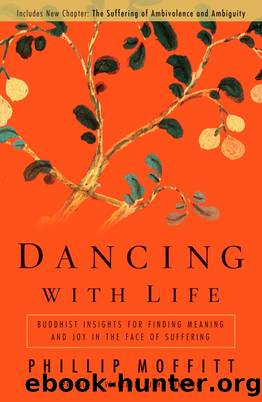Dancing With Life: Buddhist Insights for Finding Meaning and Joy in the Face of Suffering by Phillip Moffitt

Author:Phillip Moffitt [Moffitt, Phillip]
Language: eng
Format: epub, mobi, azw3
Tags: Non-Fiction, Self Help, Spirituality, Buddhism, Philosophy, Religion, Psychology
ISBN: 9781605298962
Publisher: Harmony/Rodale
Published: 2008-04-14T14:00:00+00:00
DANCING WITH LIFE WHILE CULTIVATING CESSATION
To cultivate cessation, I consciously live with the question, how do I find freedom of mind right now, even in my state of ignorance? Over and over again, I inquire and reflect: Is this thought, word, or action suffering or not suffering? Sometimes cessation happens spontaneously from this inquiry, but other times my attachment is so strong that I have to engage in right effort (which I describe in more detail in Chapter 20). If cessation still does not come about, then I simply continue inviting cessation to occur, and either the grasping releases or it doesnât. If I start making judgments about myself, such thoughts only get in the way of release happening.
This process of mindful inquiry that I am describing arises out of the ground of my intention to not cause harm to myself or others. It is not dependent on my perfection or even my ability to know for sure if a given act is skillful or not. Likewise, the practice of clear intention to not cause harm forms the foundation for you to cultivate wisdom and compassion and it utilizes all your experiencesâboth your wise and foolish choicesâfor you to grow deeper and more profound in your understanding.
Having practiced many years with a not-knowing attitude, I can tell you how it is to continue dancing with life as one moves along the path of realizing cessation. I have both my own experience and the teachings of those who have guided me thus far as resources to offer you. Like the scholar with the overflowing teacup discovered, an intuitive feel for cessation will serve you best, not some intellectual definition or some very specific experience that you grasp and begin to crave.
Ajahn Sumedho teaches that the path of cessation comes through being mindful and reflective of your immediate life experience and utilizing inquiry and reflection to go beneath the surface appearance of things: âPeople rarely realize cessation because it takes a special kind of willingness in order to ponder and investigate and get beyond the gross and the obvious. It takes a willingness to actually look at your own reactions, to be able to see the attachments and to contemplate: âWhat does attachment feel like?ââ Sumedhoâs words echo the wisdom of his teacher, Ajahn Chah, who said, âAs you proceed with your practice you must be willing to examine every experience.â12
Sumedho goes on to say, âIn my practice, I have seen that attachment to my desires is suffering. Attachment is to be understood and contemplated; then the insight into nonattachment [cessation] arises. This is not an intellectual stand or a command from your brain saying that you should not be attached; it is just a naturally arising insight into nonattachment or nonsuffering.â Then he explains how this reflection on attachment brings the insights of cessation: âWe reflect as we see the nature of desire; as we recognize that attachment to desire is suffering. Then we have the insight of allowing desire to go and the realization of nonsuffering, that is the cessation of suffering.
Download
Dancing With Life: Buddhist Insights for Finding Meaning and Joy in the Face of Suffering by Phillip Moffitt.mobi
Dancing With Life: Buddhist Insights for Finding Meaning and Joy in the Face of Suffering by Phillip Moffitt.azw3
This site does not store any files on its server. We only index and link to content provided by other sites. Please contact the content providers to delete copyright contents if any and email us, we'll remove relevant links or contents immediately.
The Way of Zen by Alan W. Watts(6511)
Ego Is the Enemy by Ryan Holiday(5297)
The Art of Happiness by The Dalai Lama(4063)
The Book of Joy by Dalai Lama(3904)
Why Buddhism is True by Robert Wright(3405)
Spark Joy by Marie Kondo(3252)
Shift into Freedom by Loch Kelly(3137)
Happiness by Matthieu Ricard(2993)
A Monk's Guide to a Clean House and Mind by Shoukei Matsumoto(2870)
The Lost Art of Good Conversation by Sakyong Mipham(2578)
The Meaning of the Library by unknow(2508)
The Unfettered Mind: Writings from a Zen Master to a Master Swordsman by Takuan Soho(2249)
The Third Eye by T. Lobsang Rampa(2226)
Anthology by T J(2162)
Red Shambhala by Andrei Znamenski(2154)
The Diamond Cutter by Geshe Michael Roach(2022)
Thoughts Without A Thinker: Psychotherapy from a Buddhist Perspective by Epstein Mark(1962)
Twilight of Idols and Anti-Christ by Friedrich Nietzsche(1851)
Advice Not Given by Mark Epstein(1839)
